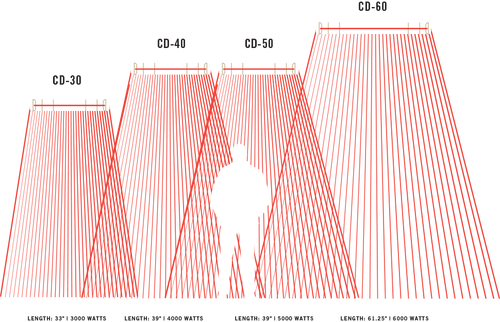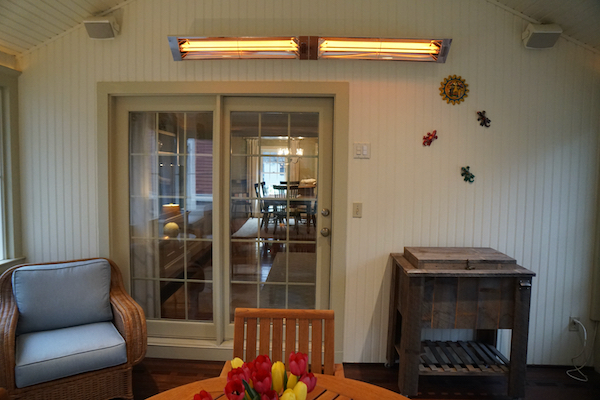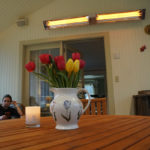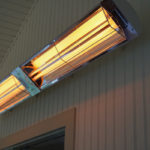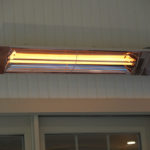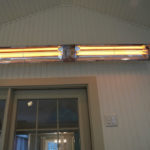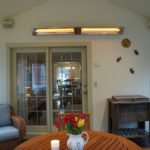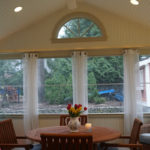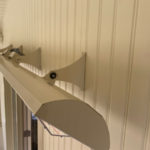Installing An Infratech Heater
Using Infratech Infrared Heaters On Screen Porch
Staying home during the COVID pandemic showed us that space at home is premium. Extending the outdoor living spaces longer into the fall, or even a winter season is something people are looking at more than ever. We’ve seen the restaurants build out their outdoor ding, many using infrared heaters. That got us thinking, why not use these heaters on a residential project?
Outfitting A Screen Porch With Infrared Heaters
We decided to use Infrared heaters on a screen porch build-out, to accomplish this extended outdoor living goal. We chose the Infratech heater brand mostly based on their reputation, safety features, and aesthetics.
READ: Creating an Outdoor Living Space
Infratech Heaters
Infratech heaters are a recognized name in the heating industry. Their heaters use infrared heat in the form of shortwave or mediumwave radiation. An Infratech heater uses an element in a quartz tube, which is different than a gas heater, which uses an open flame. Because you don’t have to worry about an open flame, infrared heaters require less clearance around them for safety. This means they can often be placed in tighter quarters and can be mounted flush in a ceiling to reduce visual impact.
This makes Infratech effective in both enclosed and open-air outdoor living spaces because you don’t have to worry about trapping and recirculating the air once it’s been heated. Infratech heating elements are rated for 5,000 hours of continuous use.
Heating Objects Versus Heating the Air
Infrared heaters don’t heat the air. They heat the objects at which they are pointed. This direct heat transfer is fundamentally different than other heating unit methods. This is why Infratech heaters are feasible in open-air settings. You’re not trying to heat the air; you’re heating the actual seating areas and objects instead.
Infratech Heater System Components
Once you’ve chosen your product, there are other components that can be included in your project, depending on size and budget.
- Value Control [$120] Used to control one, single-element heater.
- Duplex Switch Simple switch to control two heaters at ½ heat or full heat.
- Relay box Control options for your heating system range from simple on- and off-switches to advanced solid-state control systems and custom controllers.
- Custom Controls [$2,000] Custom-made controls offer dimmer switches, giving you the full range of output regulation—from 0 to 100 percent, and zoning.
- Universal Panel [$1,500-2000] This option includes smartphone and voice controls. A universal panel can control up to 8 heaters and can be connected with Bluetooth, Alexa, and Lutron interfaces.
- Home Management Systems Infratech is currently the only heater that can connect to home smart systems. [Lutron / Creston / Control 4]
- Timer It’s important to include a timer in your system to ensure you don’t leave the heater on by mistake, wasting energy and money.
- Circuit Each individual heater will require its own large circuit, so if there’s not enough room in your circuit box, you may need to install a dedicated circuit.
Installing Two Infratech Heaters Side-By-Side
For this installation, the electrician had to install a 30 amp circuit breaker and dedicated wire for each heater. We ended up removing some of the existing tongue and groove paneling in the porch to assist the electrician on this installation.
Opening the wall allowed us to eliminate an old cable box and remove an outlet from an old TV. It also allowed us to snake the wires up above the terrace door header.
The 14’x14’ cathedral ceiling, screened porch has Mylar storm panels in the winter months, which eliminates any wind issues. Using the rule of thumb of one heater heats a 10’x10’ area, we chose to install two heaters side by side, eight feet high, to ensure even coverage throughout the 14-foot by 14-foot porch.
Both heaters face outward and are controlled by a Duplex switch, allowing me to individually operate my two heaters on ½ heat, or high heat, or a combination of both. My electrician installed the units after we patched in the wall paneling.
Sizing Pro Tip:
When choosing whether to go with one or more heaters consider personal expectations and wind exposure. If in doubt, go higher in heater wattage, choose a dual element over a single element heater or increase the number of heaters used, and then “dial down” the heat with a controller.
Infratech Heater Mounting Clearances
The Infratech heater must be installed with the quartz tube horizontally level. It’s important to always maintain the minimum clearances from the heater body to any combustible materials.
Infratech heater clearances:
- Minimum 18″ clearance on all four sides
- Minimum 36″ directly in front
- Minimum 72″ from floor
- Minimum 6″ clearance provided by wall mounting brackets
Infratech Mounting Options
When choosing an infrared heater consider mounting options, Infratech offers three choices:
- Flush [most popular – flush mount in ceiling]
- Wall [wall mount brackets are shown above]
- Pole [8-foot pole with 12” x 12” heavy base.
- Ceiling Mounted (Mounting Brackets included in heaters)
When wall mounting like we did it is recommended that you angle fixture 30 to 60 degrees from horizontal face down, with 45-degrees as being the best angle. It is also recommended to install the heater to heat from the cold side, if possible.
Smart Home Controlling
Infratech heaters can be controlled from home management systems. There are two ways to integrate Infratech’s solid-state controls into your home management system:
- On/off and timer functionality only, by switching the 120-volt power to the analog remote.
- Full integration with Infratech’s controls designed to accept a 0-10-volt DC signal from the home management system, to vary the intensity of the heaters.

Cost to Install
The total cost of purchasing and installing an infrared heating system for your screened porch will typically be around $1000 to 1600 per heater, depending on where you live and electrician costs. The overall cost may be affected if you need to upgrade your circuit box or repair drywall for the project.
To figure out your cost use this formula check out our article Choosing An Infrared Heater
Placement of Heater
One Infratech heater heats an area approximately ten feet in radius. Infratech offers engineering help to potential clients. Send your photos, plans, and dimensions to them and they will provide you with options on heaters, colors, and controls.
When considering heater placement always choose a heater size with the appropriate heat output for the mounting height and area to cover. By selecting a smaller unit, you may require more heaters to get the same amount of heat output. Screen porch or patio heating is often a compromise between functionality and finding the desired look.
Infratech vs. a Gas Heater
Infratech heaters use elements within quartz tubes, while gas heating systems use open flames.
An Infratech heater can even be mounted flush within walls or ceilings, and tend to be smaller than gas units. Gas units need that clearance to safely operate, which means they often hang down or stick out further into the room or area. Wind diminishes a gas heater’s efficiency and the effectiveness of the heater. An Infratech heater is unaffected by wind.
Cost to Run an Infratech Heater
At 4000-watts, an Infratech heater will cost [according to National Ave] $0.60 an hour to run at 93% efficiency. In comparison, propane costs $ 2.00 an hour to run and gas $0.45 an hour but runs at 60% effective due to the heat rising and lost efficiency — even in windless conditions.
How Much Heat Did We Get?
With both heaters on “low,” we achieved even heat throughout the screen porch on a 45-degree day. On “high,” the heat was too much. I’m sure when on “high” the porch will be habitable at a much lower temperature.

Overall Thoughts on the Infratech Heaters
When choosing an Infratech infrared heater remember that they’re an efficient way to heat and the most cost-effective in the long term. Infrared heaters are silent, provide efficient heating, odorless, do not require propane or gas, are low maintenance, and are easy and convenient to operate.
Installing an Infratech Heater













